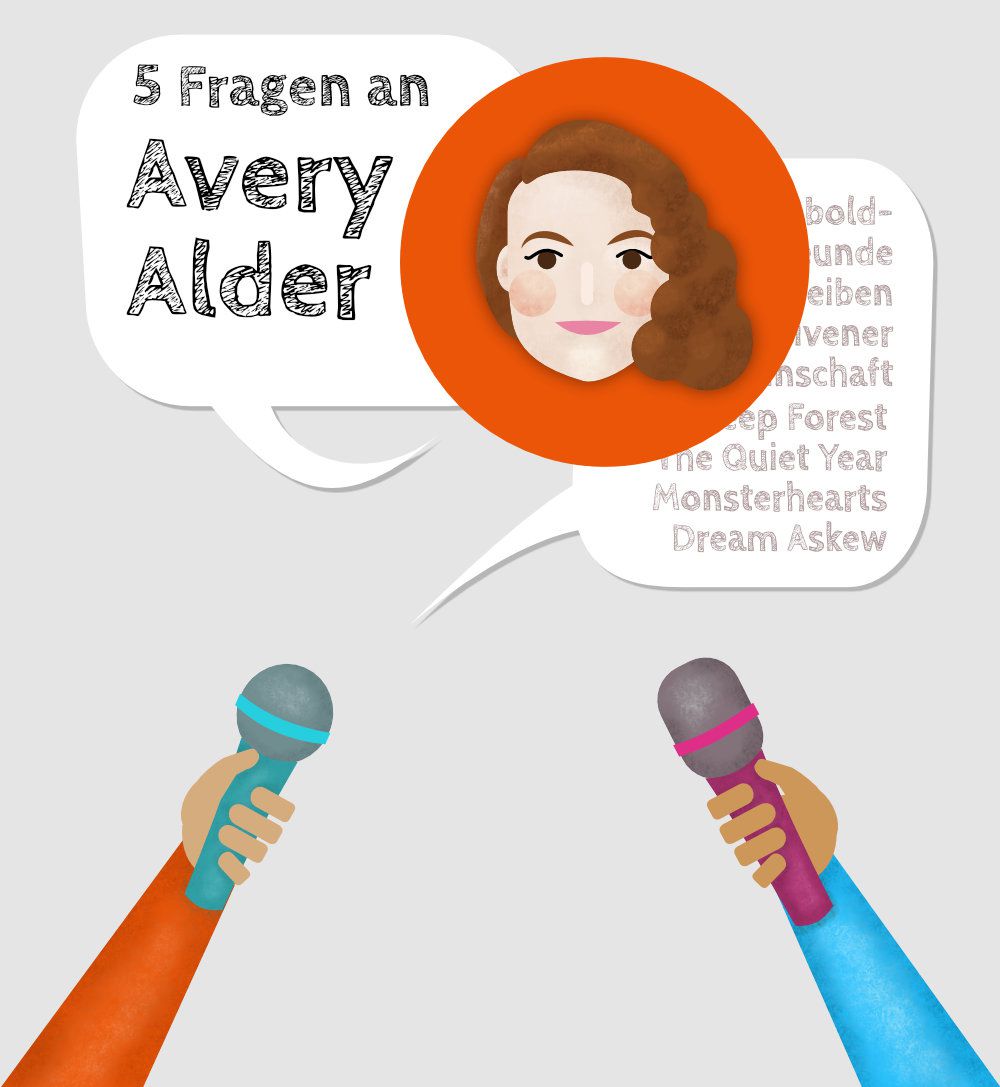Five Questions for Avery Alder
Von Tina am 12. Juni 2018English version of our interview with Avery Alder
1.792 Wörter, ungefähre Lesedauer 9 Min.
I conducted this interview with game designer Avery Alder back in May over email. A German translation was published on June 10th 2018 in the German-language indie RPG and storygame zine “Erzählspiel-Zine”. Here’s the original English version for international readers. Enjoy!

1. The Quiet Year and The Deep Forest
The Quiet Year (TQY), released in 2013, is a GMless, collaborative map-drawing storygame about a post-apocalyptic community. The Deep Forest is an early 2015 re-imagining of TQY that focuses on a postcolonial community of monsters instead of the common exploration and colonization themes of many other games, and even TQY itself.

On Twitter, you recently said that The Quiet Year is one of two favorites among your own games. What do you like about it the most, and does the same apply to The Deep Forest?
Avery: My favourite thing about The Quiet Year is how the constraints of the game lead people to have a implicit conversation about what they think community process should look like, often without realizing it. Every week is a turn belonging to one player, and they need to choose whether the community prioritizes exploration, dialogue, or action. Others can’t direct you in this choice: it needs to come from your gut. But the game gives the other players space to react, in the form of Contempt Tokens. And so while a story is getting told through the map and the fiction of the game, another conversation is also happening under the surface: players are taking turns demonstrating how they think a community works.
2. Dream Askew/Dream Apart
Dream Askew is on Kickstarter right now, together with a parallel version, Dream Apart by Ben Rosenbaum. Both are diceless, GMless pbtA games. Avery described them recently as “a game about queer community strife as the world collapses” and “a game about fantastical Jewish shtetl life”, respectively. She also recently named Dream Askew the other one of your two favorites among your games (beside The Quiet Year).
Most of her games revolve around queerness in one way or another, but Dream Askew may be the most unapologetically queer yet.
The first version of Dream Askew came out in 2013, but despite several groundbreaking design features - ”no dice, no masters”, as she calls it), some people feel the game hasn’t received the success it maybe deserves in the past because it is such a “niche” game and non-queers haven’t really latched on to it. There have been speculations that non-queer people are either not drawn to the theme or feel they can’t do it justice in play, being insecure about cultural appropriation of a marginalized group or afraid of falling into inappropriate stereotypes due to inexperience.
Dream Apart, Askew’s “partner game” is about a different marginalized community, and it looks like people are also working on other more generalized hacks of Dream Askew.

How closely is Dream Askew’s theme linked to its game mechanics, in your opinion; how important is that to you, and how do you feel about people making hacks that are about other groups, or even non-marginalized groups?
Avery: I think that the mechanics are closely linked to the themes of community, solidarity, and identity. In the new edition, setup involves collaboratively filling out a community worksheet which sets up conflicts and possibilities that the community is working through.
It’s rare that those problems are entirely external, with the characters standing united as heroes. Usually, the community worksheet establishes a situation where the outside world puts intense pressure on this marginalized community, and it forces those in the community to either reconcile or double down on their animosities and differences. And in play, the mechanics again work to interrogate the idea of rugged individualist heroes.
In order to make a Strong Move, you need a token. The two ways to get tokens are to make a Weak Move (meaning that your heroic deeds are tempered by your mistakes and follies along the way) or to have someone come to you for help in a way that triggers your Lure (which means your strength comes from community interdependency). These mechanics are all simple and streamlined, but they point toward interconnectedness and community. In addition to saying that Dream Askew and Dream Apart feature a no dice, no masters system, we also call them games of belonging outside belonging.
3. Monsterhearts
The first version of Monsterhearts , a pbtA game about “the messy lives of sexy teenage monsters”—vampires, werewolves, witches, ghosts, and other supernatural romance/horror characters, came out in 2012 and has been hugely popular. Its genre inspirations are listed as Twilight, Ginger Snaps, The Vampire Diaries, True Blood, and Buffy, among others. In 2017, a second edition, Monsterhearts 2, was kickstarted and delivered.

For this game, I’m really interested in translations and localizations - I know that at least an Italian version of Monsterhearts exists, with more being in the works, I’m sure.
What is most important to you when international publishers approach you about translated editions - is there something that you feel they must (or must not) contain, retain, or change at all costs? Language and gender consideration, style and content of the artwork, or setting adjustments - Monsterhearts and most supplements are set in North American High Schools - is changing the setting to European places appropriate or encouraged?
A short illustration for the problem of language and gender: One thing that many German game translations struggle with is the fact that in German, like many European languages, nouns like player, character, GM, etc., are gendered, and gendered male. There is no convenient way to make them gender neutral, such as “they” in English.
Avery: I feel really honoured that my work has been translated into Korean, Italian, Spanish, Portuguese, French, and more. I don’t make very much in royalties from these other markets, and so for me the biggest impact that these translations bring is that more people get to play. It’s about accessibility and building an international community. I try not to make a lot of requests of translators because I don’t know their language or their market! But if a game has explicitly queer themes, I ask them to do their best to put a queer person in charge of translation. There are a few reasons for this: first, I want queer people to get paid as often as possible; second, I am politically aligned with the notion that queer people deserve ownership over how they are represented in the world; and finally, given that every language handles gender in a different way, for games that feature complicated and pointed unravelings of gender and its power structures, it’s important to have a translator who is poised to meaningfully engage with and localize those dynamics.
4. Accessibility and clear writing
Avery’s games have a reputation for being accessible - they are usually clearly structured and well written. People often name Monsterhearts as one of the best-written RPGs they know; The Quiet Year and Dream Askew have also been praised for being being easy to read, understand, and teach without putting a single player in the spotlight as a moderator/rules reader.

Is that something you intentionally set out to achieve from the beginning? (Maybe you’re just naturally good at accessible game writing, but I suspect it is a lot of work!) If so, how do you go about achieving it - do you have a specific process you follow for structuring, writing/testing/rewriting your rules texts?
Avery: I’m flattered! I think this is one of the highest forms of praise that a game designer can receive. And yes, I work really hard to produce accessible texts. I’ve always been excited about designing games that cut away anything superfluous and hone down to only that which truly matters, which I think goes a long way toward producing accessible work.
I think that part of my striving to produce accessible, lucid, concise writing is that I am working with themes and stories from the margins. In order to present strange and unfamiliar ideas and have them still register in people’s minds, I need to be really judicious and thoughtful about my words. That said, I also want my text to be poetic and overwrought and beautiful, which means finding a balance.
In terms of tools to achieve concise, lucid game design texts, the stand-out for me is definitely Scrivener, a writing program which allows you to break your writing across dozens of smaller sub-files, all labelled and tagged with metadata. It completely changed how I approach writing big texts. Instead of starting at the beginning and trying to barrel through without losing my voice or getting jumbled up, I start by establishing a flow and structure for the document. I play around with order of presentation and overall vision, before moving on to the process of putting words on the page. It’s trained me to think about instructional design in a more high-level, process-oriented way.
And in terms of techniques, I think the most important one is playtesting with people who’ve never played roleplaying games before. I ran a drop-in, beginner-friendly, weekly gaming night for a few years. I run games for community groups, family members, and new friends. When your game is someone’s entry-point into roleplaying, you quickly realize what concepts and expressions are opaque to the average reader.
Learning More

If people are interested in learning more about your work and supporting it, where should they turn?
Avery: There are two answers to that question at the moment! The first is that I have a patron network called the Goblin Friendship Club. It’s a seasonal subscription service, and it funds some of the work I’m most excited to do: offering discounts to low-income customers, working on scrappy side projects, and running a mentorship program for emerging designers. At current, I’m working with eight designers from around the world. Each mentorship is playing out differently; their games are at different stages, and moving in different directions. The Goblin Friendship Club directly supports that work, as well as just providing me with more financial security and the freedom to pursue the projects I’m most passionate about.
But right now, I’m also in the midst of a Kickstarter campaign! It’s a split book, containing two companion games: Dream Askew (by myself) is a game of queer community amid the collapse of civilization, while Dream Apart (by Benjamin Rosenbaum) is a game of fantastical Jewish shtetl life in nineteenth-century Eastern Europe. They’re both games of belonging outside belonging, telling stories about community drama and support. They feature a beginner-friendly “no dice, no masters” system that puts focus on relationships, identity, and choice. I’m really proud of this project. You can find a link to the Kickstarter by visiting here.